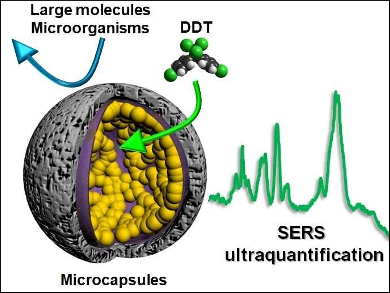Surface-enhanced Raman scattering (SERS)-based sensors are promising for the direct analysis of environmental samples. However, problems such as the stability of the sensors in the surrounding media and the chemical complexity of natural samples hinder their practical use.
Ramon A. Alvarez-Puebla, Institució Catalana de Recerca i Estudis Avançats (ICREA), Barcelona, Spain, and Universitat Rovira I Virgili, Tarragona, Spain, Miguel A. Correa-Duarte, Universidade de Vigo, Spain, and colleagues have designed a multifunctional colloidal material. The material contains microporous silica capsules, which are internally coated with a film of interacting gold nanoparticles. The metallic nanostructured component highly enhances the SERS read-out, while the silica shell provides colloidal stability in the complex media, as well as molecular sieving properties.
The synthesis involved depositing 3 nm Au seeds onto 500 nm diameter polystyrene (PS) particles using electrostatic attraction. The resulting particles were coated with a homogeneous microporous silica layer using tetraethoxysilane in ethanol. Finally, the PS core was removed by calcination at 600 °C.
The researchers successfully used the hybrid capsules in the analysis of dichlorodiphenyl-trichloroethane (DDT), a ubiquitous environmental pollutant, in natural waters. The interaction of large molecules and microorganisms with the gold surfaces is prevented by the silica shell, while DDT is free to diffuse through the shell and adhere onto the metallic film, thus yielding intense SERS spectra for ultrasensitive quantification.
- Microporous plasmonic capsules as stable molecular sieves for direct SERS quantification of small pollutants in natural waters,
Ramon A Alvarez-Puebla, Ana Sousa-Castillo, Andrea Mariño-Lopez, Maria Blanco-Formoso, Leonardo N. Furini, Laura Rodríguez-Lorenzo, Nicolas Pazos-Perez, Luca Guerrini, Moises Pérez-Lorenzo, Miguel A. Correa-Duarte,
ChemNanoMat 2018.
https://doi.org/10.1002/cnma.201800355




